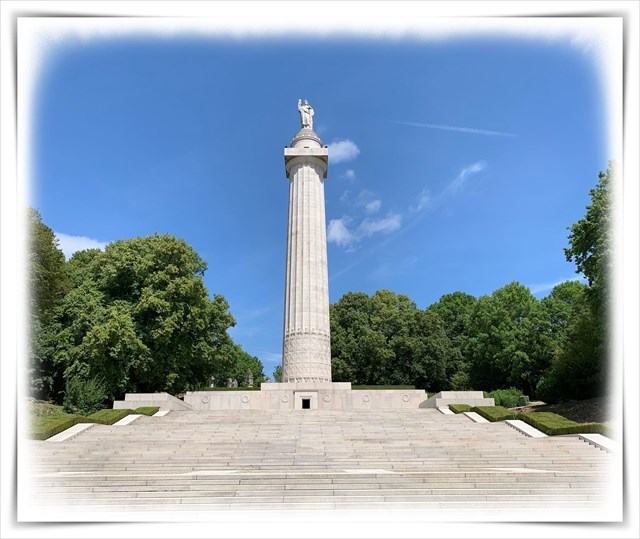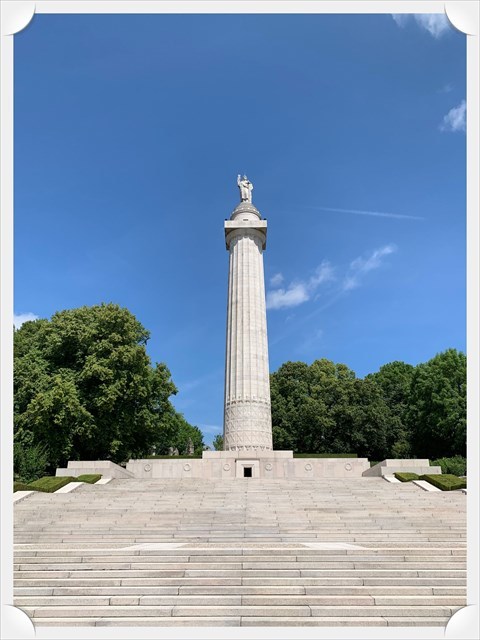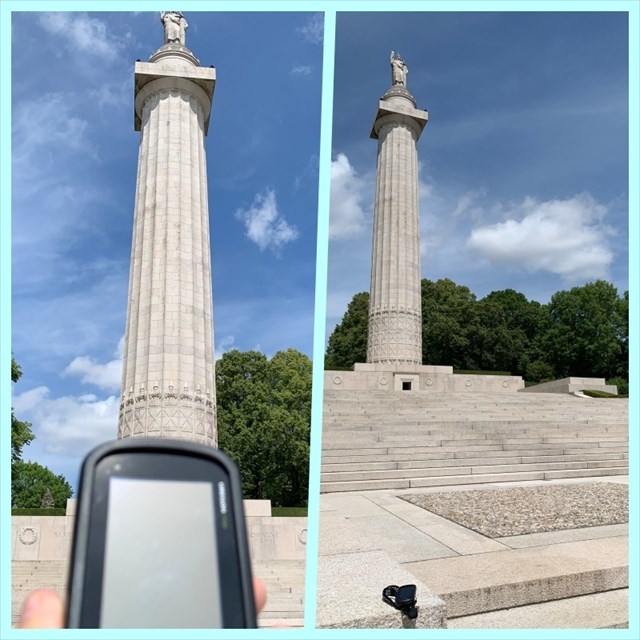
Français
"Le temps ne ternira pas la gloire de leurs actions."
- JOHN J. PERSHING, GENERAL DES ARMEES

Contexte historique
Ce monument commémore le succès de l'offensive américaine dite "Meuse-Argonne", qui fut la dernière opération d'envergure menée lors de la Première Guerre mondiale entre le 26 septembre et le 11 novembre 1918 au nord et au nord-ouest de Verdun. Ce fut l'engagement le plus important jamais entrepris par le corps expéditionnaire américain, l'American Expeditionary Force (AEF). Les forces américaines étaient composées de dix divisions de la 1re Armée, commandées initialement par le général John Pershing. En face d'elles se trouvaient des troupes allemandes dont la plus significative était la Ve armée commandée par le général Georg Von der Marwitz. Cette opération poussa l’armée allemande à la défaite finale et à la signature de l’armistice du 11 novembre qui mit fin aux hostilités.
Cette offensive se déroula en trois phases :
Première phase : 26 septembre au 3 octobre
Seconde phase : 14 au 28 octobre
Troisième phase : 28 octobre au 11 novembre
Première phase : 26 septembre au 3 octobre (Bataille de Champagne et d’Argonne)
La première armée du corps expéditionnaire américain du général John Pershing lance ce qui deviendra la bataille de l'Argonne, au nord de Verdun. C'est l'une des batailles prévues par le maréchal français Ferdinand Foch afin que les Allemands abandonnent leurs défenses sur la ligne Hindenburg et finissent par capituler.
La première armée de John Pershing, comptant un million d'hommes environ, répartis en trois corps, tient un front de 27 kilomètres de Forges à la Meuse jusque dans la forêt d'Argonne.
À gauche de la première armée américaine se tient la 4e armée française du général français Henri Gouraud. Les forces américaines font face au groupe d'armée du général allemand Max von Gallwitz, tandis que les Français affrontent le groupe d'armées du prince royal de Prusse Frédéric-Guillaume. Les Américains et les Français déploient 37 divisions, alors que les Allemands n'en disposent que de 24. Ils tiennent trois lignes de défenses fortifiées sur un terrain difficile.

L'attaque est lancée à 5 h 25 le 26 septembre et les forces américaines gagnent rapidement du terrain, avançant de 5 kilomètres environ dès le premier jour de l'offensive. La progression des Français est moins spectaculaire mais Gouraud cueille 7 000 prisonniers. Le 27, les attaques reprennent : les Allemands dépêchent des renforts dans le secteur et ralentissent l'avancée des troupes alliées. L'armée Gouraud emporte le plateau de Grateuil et fait 3 000 prisonniers ; la 1re armée américaine enlève Montfaucon, en deux jours, elle ramasse 8 000 prisonniers et 100 canons. Mais, mal ravitaillés, embouteillés dans la forêt d'Argonne, très éprouvés par les bombardements, les corps américains n'avancent plus guère, et il en est de même de l'armée Gouraud. Le 30, l'offensive est arrêtée ; elle n'a pas donné tous les résultats qu'on attendait d'elle. À la fin de la bataille, le 3 octobre, deux des trois lignes de défense allemandes seulement sont tombées dans le secteur français.
L'offensive reprend le 3 octobre. La 4e armée de Gouraud, renforcée par la 2e division d’infanterie américaine (avec la 36e d’infanterie américaine en soutien), enlève le plateau de Notre-Dame-des-Champs (21e DI française), puis les hauteurs d'Orfeuil (73e DI) pendant que Berthelot (5e armée) emporte le massif de Saint-Thierry. Les Allemands doivent évacuer la région des Monts et battent en retraite, poursuivis par Gouraud jusqu'à l'Aisne qui entre le 12 à Vouziers. Sur la rive droite de la Meuse, l'armée américaine progresse en direction du col de Grandpré.
- Bataille de Saint-Thierry :
30 septembre. - L'attaque fut déclenchée à 5 h 30, et en vue de réaliser une surprise plus complète, il n'y eut pas de préparation préalable d'artillerie. Précédée d'un barrage roulant très dense, l'infanterie se porta en avant sur toute la ligne. Au 5e corps, le franchissement de la Vesle sous le feu fut exécuté de la façon la plus remarquable. Bien que surprises, les troupes allemandes opposèrent une très énergique résistance, surtout à Romain et à Montigny-sur-Vesle ; ses défenses furent néanmoins conquises, pied à pied, sur une profondeur de 2 000 mètres.
1er octobre. - Les attaques furent reprises au point du jour. Ébranlées par les coups qui lui avaient été portés la veille, les troupes allemandes se résignèrent à céder le terrain et se replièrent en combattant dans la direction de l'Aisne et du canal de l'Aisne à la Marne.
2 octobre. - La VIIe armée de von Eberhardt abandonnant la « bretelle » de Romain et la position de la Vesle, le mouvement en avant se précipita et, le 2 au soir, il n'y avait plus au sud de l'Aisne et à l'ouest du canal que des arrière-gardes tenant le bois de Gernicourt, Loivre et Courcy.
3 octobre. - Après une courte mais intense préparation d’artillerie, le 95e RI s’empare de Loivre, ce qui permet en fin de journée aux unités de la 16e DI de border le canal de la Marne à l’Aisne, entrainant le report en arrière de la Ire armée (von Mudra).
4 au 5 octobre. - Le repli étant inévitable, von Below fait détruire les approvisionnements en vivres et en munitions accumulés dans le massif des Monts et dans les forts de Reims.
6 octobre, au matin, Brimont, Bourgogne, Bétheny, La Pompelle, Beine et Moronvilliers sont évacués par les Allemands.
En quatre jours, la Ve armée avait capturé 2 500 prisonniers et 30 canons. La première partie de l'opération était terminée et l'armée s'apprêtait à exécuter la seconde lorsque l'ennemi commença à se dérober de Reims à l'Argonne. Les attaques de la IVe et de la Ve armée avaient donné au front de Champagne la forme d'une vaste poche dont le fond s'étendait du fort de la Pompelle à Auberive, et dont le cours de la Suippe prolongé par celui de l'Armes à partir de Bétheniville marquait l'entrée. Se rendant compte du danger que les pressions latérales des IVe et Ve armées faisaient courir aux défenseurs de Nogent-l'Abbesse et du massif de Moronvilliers, von Below, dont la situation générale s'aggravait de jour en jour, se décida à évacuer la poche et se replia d'abord sur la ligne Suippe-Arnes, puis derrière l'Aisne, sur la position Brunehild-Kriemhild. Le mouvement de retraite commença le 4 octobre devant la IVe armée et, le 5, il s'étendait sur le front de la Ve jusqu'à l'Aisne, à Berry-au-Bac.
Seconde phase : 14 au 28 octobre
La deuxième phase de l'offensive franco-américaine de l'Argonne commence le 14, après une période de réorganisation au cours de laquelle les forces américaines engagées dans la bataille ont été divisées en deux armées : la Première sous les ordres du général Hunter Liggett et la deuxième commandée par le général Robert Lee Bullard. Le général John Pershing est commandant général des deux armées.
Dans son instruction du 11 octobre, Pétain a fixé les objectifs : pour la 1re armée américaine, rompre la position Kriemhild en atteignant Buzancy et la falaise de Dun-Danvillers et pour la 4e armée française, manœuvrer le front allemand de l'Aisne en attaquant par l'est de Vouziers.
- Bataille de Vouziers-Grandpré
Le 14 octobre, le 1er corps américain (Première armée américaine de Liggett) s'empare de Saint-Juvin, pénètre avec quelques éléments dans Grandpré et aborde la position Kriemhild en se heurtant à un véritable barrage d'armes automatiques. Pour protéger le flanc de l'attaque américaine, Gouraud réussit à s'établir avec le 38e corps en tête de pont de l'autre côté de l'Aisne, au nord de Termes, Mouron (Ardennes), Brécy et Olizy.
Les 16 et 17 octobre, profitant de l'avance du 38e corps français, la 1re armée américaine réoccupe Grandpré, pousse jusqu'à Champigneulle et s'efforce du 21 au 23 à déboucher de Romagne-sous-Montfaucon.
Le 18 octobre, sur le flanc de la IIIe armée allemande, le 38e corps élargit sa tête de pont et le 9e corps (134e, 53e et 73e divisions) réussit à franchir les prairies inondées des bords de l'Aisne et aborde les rebords de l'Argonne.
Le 23 octobre, les régiments tchécoslovaques de la 53e division enlèvent Terron pendant que les Américains progressent de part et d'autre de la Meuse, vers Bantheville et vers le bois des Caures et d'Ormont.
Les Allemands sont obligés de dépêcher des renforts depuis d'autres secteurs menacés sur le front occidental pour contrer les Français et les Américains. Chaque camp essuie de lourdes pertes lors des combats, qui s'épuisent à la fin du mois. Les troupes de Pershing ont cependant percé la troisième et dernière ligne de défense allemande.
L'offensive de l'Argonne est renouvelée au début du mois de novembre, après une période de repos et d'envoi de renforts : relève des 82e et 42e divisions durement éprouvées, augmentation des canons de campagne pour remplacer les canons lourds encombrant l’arrière.
Troisième phase : 28 octobre au 11 novembre
La troisième et dernière phase de l'offensive de l'Argonne, dirigée par les Américains, commence. La Première armée américaine sous les ordres du lieutenant-général Hunter Liggett reprend son avancée dans le nord et perce les défenses allemandes de Buzancy, ce qui permet à la 4e Armée française de traverser l'Aisne.
- Bataille du Chesne et de Buzancy
La résistance allemande s'effondre et les forces américaines progressent rapidement dans la vallée de la Meuse en direction de Sedan qui tombe le 6. Bien que l'offensive progresse encore, elle prend fin à la signature de l'armistice le 11 novembre.
(Sources : Wikipédia, Ministère des Armées - Direction des patrimoines, de la mémoire et des archives)
Le monument

Le Mémorial Américain s’élève sur les hauteurs du village de Montfaucon d’Argonne à environ 25 km de Clermont en Argonne. Il commémore la victoire de l’armée américaine lors de l’Offensive Meuse Argonne et la reprise de la colline de Montfaucon les 26 et 27 septembre 1918.
Ce monument a été érigé par la Commission des monuments de guerre américains (American Battle Monuments Commission), une agence gouvernementale des Etats-Unis d’Amérique qui en assure également l’entretien. C’est le site de l’ancien village de Montfaucon qui, détruit pendant la Première Guerre mondiale, fut ultérieurement reconstruit à quelques centaines de mètres à l’ouest. Juste derrière le monument subsistent les ruines de l’église de Montfaucon. Il reste très peu de l’ancien village. Point culminant entre la Meuse à l’est et la forêt d’Argonne à l’ouest, cette colline fut la scène de nombreuses batailles sanglantes au cours de l’histoire.
L’architecte de ce mémorial est John Russel Pope de New-York. Financé par des capitaux américains, le monument fut achevé en 1933. Il fut inauguré le 1er août 1937 par la Président de la République française, Albert Lebrun et en présence des généraux Pétain et Pershing. Aussi, à cette occasion, le président américain, Frank D. Roosevelt prononça depuis Washington, un discours qui fut retransmis en direct.
Le monument, d’une hauteur totale de 60 mètres, est surmonté d’une statue symbolisant la liberté, appelée le Génie Libérateur. Elle fait face à la ligne de front de la Première Armée américaine au matin du 26 septembre 1918 lorsque l’attaque débuta.
Un escalier de 234 marches mène en haut de cette colonne. Arrivé sur la plate-forme d’observation, vous découvrirez le champ de bataille.
Enfin, les noms des secteurs repris par les Américains sont inscrits sur le mur de la façade du monument.
HORAIRES (pour l'accès à la plate-forme d'observation) :
La tour est rouverte au public depuis le 24 juillet 2023 du lundi au vendredi de 9h à 15h30 sauf jours fériés français et américains.
De mars à avril : tous les jours de 9h à 19h
De mai à septembre : tous les jours de 9h à 21h
D’octobre à novembre : tous les jours de 9h à 19h
De décembre à février : tous les jours de 9h à 17h
VISITE LIBRE
(Sources : Office de tourisme du Pays d’Argonne, Ministère des Armées - Direction des patrimoines, de la mémoire et des archives)
Conditions pour valider votre visite:
1 - Allez aux coordonnées de la virtuelle (devant la façade du monument) et répondez aux questions suivantes :
Vous voici devant l’entrée du monument. A la base de celui-ci, se trouvent toutes les divisions américaines et françaises qui furent engagées dans la bataille de Meuse-Argonne.
1.1 Observez bien tous les murs et donnez-moi le nombre exact de divisions américaines.
1.2 Quelles sont les deux divisions ayant combattu à « Stenay » ?
1.3 Sur le mur de droite, relevez le nombre de divisions françaises. L’une d’entre elles était en réserve. Pouvez-vous me la citer ?
1.4 Optionnel. Rejoignez la plate-forme d'observation (voir horaires) au sommet de la tour et donnez-moi la distance Montfaucon - Sedan. Une photo depuis la plate-forme est possible, mais sera à inclure dans votre log (voir conditions ci-dessous).
2 - Postez une photo de vous, de votre gps ou d'un autre objet avec le monument en arrière plan ou depuis la plate-forme d'observation (si vous réalisez l'étape optionnelle) dans votre log. (Les photos montrant les visages sont totalement facultatives pour garantir la confidentialité de chacun). Tout log sans photo sera supprimé, de même que ceux contenant des indices ou les réponses.

3 - Enfin, enregistrez cette cache comme "trouvée" et envoyez-moi vos propositions de réponses, soit via mon profil, soit via la Messagerie Geocaching.com (Message Center). Je vous contacterai en cas de problème.
Merci de respecter le lieu
Une fois la cache loguée et si vous le souhaitez, vous pouvez mettre ce badge sur votre profil.

<a href="https://coord.info/GC891M1"><img src="https://s3.amazonaws.com/gs-geo-images/d577fa55-569b-4a69-a33b-046409e93135_l.jpg" alt="" /></a>

English
"Time will not dim the glory of their deeds."
- GENERAL OF THE ARMIES JOHN J. PERSHING

Historical background
This monument commemorates the success of the so-called American offensive "Meuse-Argonne" which was the last major operation during the First World War between September 26 and November 11, 1918 north and northwest of Verdun. This was the largest engagement ever undertaken by the American Expeditionary Force (AEF). The American forces were composed of ten divisions of the 1st Army, initially commanded by General John Pershing. Opposite them were German troops, the most significant of which was the Fifth Army commanded by General Georg Von der Marwitz. This operation pushed the German army to final defeat and the signing of the armistice of November 11, which ended the hostilities.
This offensive took place in three phases :
First phase : September 26 to October 3
Second phase : October 14 to 28
Third phase : October 28 to November 11
First phase : September 26 to October 3 (Battle of Champagne and Argonne)
The first army of General John Pershing's American Expeditionary Force launched what would become the Battle of the Argonne, north of Verdun. This was one of the battles planned by French Marshal Ferdinand Foch for the Germans to abandon their defences on the Hindenburg Line and eventually surrender.
John Pershing's first army, numbering about a million men, divided into three corps, held a 27-kilometre front from Forges à la Meuse to the Argonne forest.
To the left of the first American army is the 4th French army of French General Henri Gouraud. The American forces faced the army group of German General Max von Gallwitz, while the French faced the army group of the Royal Prince of Prussia Frederick William. The Americans and the French deployed 37 divisions, while the Germans had only 24. They held three lines of fortified defences on difficult terrain.

The attack was launched at 5:25 a.m. on September 26 and American forces rapidly gained ground, advancing about 5 kilometres from the first day of the offensive. The progress of the French was less spectacular, but Gouraud took 7,000 prisoners. On the 27th, attacks resumed : the Germans sent reinforcements to the area and slowed down the advance of Allied troops. The Gouraud army took the Grateuil plateau and took 3,000 prisoners ; the 1st American army kidnapped Montfaucon, in two days, it collected 8,000 prisoners and 100 cannons. But, poorly supplied, bottled up in the Argonne forest, very tested by the bombardments, the American bodies hardly advance any more, and the same is true of the Gouraud army. On the 30th, the offensive was stopped; it did not give all the results expected of it. At the end of the battle, on 3 October, only two of the three German lines of defence fell in the French sector.
The offensive resumed on October 3. Gouraud's 4th army, reinforced by the 2nd American infantry division (with the 36th American infantry in support), took the plateau of Notre-Dame-des-Champs (21st French ID), then the heights of Orfeuil (73rd ID) while Berthelot (5th army) took the Saint-Thierry massif. The Germans had to evacuate the Monts region and retreat, pursued by Gouraud to the Aisne which entered Vouziers on the 12th. On the right bank of the Meuse, the American army advanced towards the col de Grandpré.
- Battle of Saint-Thierry :
September 30th. - The attack was launched at 5:30 am, and in order to achieve a more complete surprise, there was no prior artillery preparation. Preceded by a very dense rolling barrage, the infantry carried forward all along the line. In the 5th Corps, the crossing of the Vesle River under fire was carried out in the most remarkable way. Although surprised, German troops resisted very strongly, especially at Romain and Montigny-sur-Vesle; its defences were nevertheless conquered, foot by foot, to a depth of 2,000 metres.
October 1st. - The attacks were resumed at dawn. Shaken by the blows that had been inflicted on them the day before, the German troops resigned themselves to giving up the ground and withdrew while fighting in the direction of the Aisne and the canal from the Aisne to the Marne.
October 2nd. - As von Eberhardt's 7th army abandoned the Roman "ramp" and the position of the Vesle, the movement forward rushed and, on the evening of the 2nd, there were only rear guards holding the woods of Gernicourt, Loivre and Courcy to the south of the Aisne and west of the canal.
October 3rd. - After a short but intense artillery preparation, the 95th IR seized Loivre, which allowed the 16th ID units to border the Marne-Aisne canal at the end of the day, leading to the relocation of the 1st army (von Mudra).
4 to 5 October. - As withdrawal was inevitable, von Below had the supplies of food and ammunition accumulated in the Monts massif and in the Reims forts destroyed.
On the morning of 6 October, Brimont, Burgundy, Bétheny, La Pompelle, Beine and Moronvilliers were evacuated by the Germans.
In four days, the Fifth Army had captured 2,500 prisoners and 30 guns. The first part of the operation was over and the army was about to execute the second part when the enemy began to flee Reims to the Argonne. The attacks of the 4th and 5th armies had given the Champagne front the shape of a vast pocket whose bottom extended from the fort of La Pompelle to Auberive, and whose course of the Suippe extended by that of the Armes from Betheniville marked the entrance. Realizing the danger that the lateral pressures of the 4th and 5th armies were running to the defenders of Nogent-l'Abbesse and the Moronvilliers massif, von Below, whose general situation was worsening day by day, decided to evacuate the pocket and withdrew first to the Suippe-Arnes line, then behind the Aisne, to the Brunehild-Kriemhild position. The retreat movement began on October 4 in front of the Fourth Army and on October 5 it extended across the front from the Fifth to the Aisne in Berry-au-Bac.
Second phase : October 14 to 28
The second phase of the Franco-American offensive on the Argonne began on the 14th, after a period of reorganization during which the American forces involved in the battle were divided into two armies: the first under General Hunter Liggett and the second under General Robert Lee Bullard. General John Pershing is Commander General of both armies
In his instruction of 11 October, Pétain set the objectives : for the 1st American army, to break the Kriemhild position by reaching Buzancy and the Dun-Danvillers cliff and for the 4th French army, to manoeuvre the German Aisne front by attacking from the east of Vouziers.
- Battle of Vouziers-Grandpré
On October 14, the 1st American Corps (Liggett's First American Army) seized Saint-Juvin, entered Grandpré with some elements and approached the Kriemhild position hitting a real barrage of automatic weapons. To protect the flank from the American attack, Gouraud managed to establish himself with the 38th corps at the bridgehead on the other side of the Aisne, north of Termes, Mouron (Ardennes), Brécy and Olizy.
On 16 and 17 October, taking advantage of the advance of the 38th French Corps, the 1st American army reoccupied Grandpré, pushed as far as Champigneulle and made efforts from 21 to 23 to open out of Romagne-sous-Montfaucon.
On 18 October, on the flank of the Third German Army, the 38th Corps widened its bridgehead and the 9th Corps (134th, 53rd and 73rd Divisions) succeeded in crossing the flooded meadows of the banks of the Aisne and approached the banks of the Argonne.
On October 23, Czechoslovak regiments of the 53rd Division kidnapped Terron while the Americans advanced on both sides of the Meuse, towards Bantheville and towards Caures and Ormont Wood.
The Germans were forced to send reinforcements from other threatened areas on the Western Front to counter the French and Americans. Each side suffered heavy losses in the fighting, which ran out at the end of the month. Pershing's troops, however, broke through the third and final German defence line.
The Argonne offensive was renewed at the beginning of November, after a period of rest and reinforcements: the 82nd and 42nd divisions were relieved, the field guns were increased to replace the heavy guns cluttering the rear.
Third phase : October 28 to November 11
The third and final phase of the Argonne offensive, led by the Americans, began. The First American Army under Lieutenant-General Hunter Liggett resumed its advance into the north and broke through the German defences of Buzancy, allowing the French 4th Army to cross the Aisne.
- Battle of Le Chesne and Buzancy
German resistance collapsed and American forces made rapid progress in the Meuse Valley towards Sedan, which fell on the 6th. Although the offensive was still progressing, it ended with the signing of the armistice on 11 November.
(Sources : Wikipédia, Ministère des Armées - Direction des patrimoines, de la mémoire et des archives)
The monument

The American Memorial stands on the heights of the village of Montfaucon d'Argonne, about 25 km from Clermont in Argonne. It commemorates the victory of the American army during the Meuse Argonne Offensive and the retaking of Montfaucon Hill on September 26 and 27, 1918.
This monument was erected by the American War Monuments Commission (American Battle Monuments Commission), a government agency of the United States of America, which also maintains it. It is the site of the former village of Montfaucon which, destroyed during the First World War, was later rebuilt a few hundred metres to the west. Just behind the monument remain the ruins of the church of Montfaucon. There is very little left of the old village. The highest point between the Meuse in the east and the Argonne forest in the west, this hill was the scene of many bloody battles throughout history.
The architect of this memorial is John Russell Pope from New York. Financed by American capital, the monument was completed in 1933. It was inaugurated on 1 August 1937 by the President of the French Republic, Albert Lebrun, in the presence of General Pétain and General Pershing. Also, on this occasion, American President Frank D. Roosevelt delivered a speech from Washington, which was broadcast live.
The monument, with a total height of 60 metres, is surmounted by a statue symbolizing freedom, called the Liberator Genie. It faced the front line of the First American Army on the morning of September 26, 1918, when the attack began.
A staircase of 234 steps leads to the top of this column. Once you arrive on the observation platform, you will discover the battlefield.
Finally, the names of the sectors taken over by the Americans are inscribed on the wall of the monument's facade.
SCHEDULE (for access to the observation platform) :
The tower reopened to the public on July 24, 2023, from Monday to Friday, 9 a.m. to 3:30 p.m., except on French and American public holidays.
From March to April: every day from 9am to 7pm
From May to September: every day from 9am to 9pm
From October to November: every day from 9am to 7pm
From December to February: every day from 9am to 5pm
FREE VISIT
(Sources : Office de tourisme du Pays d’Argonne, Ministère des Armées - Direction des patrimoines, de la mémoire et des archives)
Conditions to validate your visit:
1 - Go to the virtual coordinates (in front of the facade of the monument) and answer the following questions :
Here you are in front of the entrance of the monument. At the base of this one are all the American and French divisions that were involved in the Battle of Meuse-Argonne.
1.1 Take a good look at all the walls and give me the exact number of American divisions.
1.2 What are the two divisions that fought at "Stenay" ?
1.3 On the right wall, record the number of French divisions. One of them was in reserve. Can you name it for me ?
1.4 Optional. Join the observatory platform (see schedules) at the top of the tower and give me the distance Montfaucon - Sedan. A photo from the platform is possible, but will have to be included in your log (see conditions below).
2 - Post a picture of yourself, your GPS or another object with the monument in the background or from the observation platform (if you perform the optional step) in your log (Photos showing faces are totally optional to ensure everyone's privacy). Any log without a photo will be deleted, as well as those containing clues or answers.

3 - Finally, save this cache as "found" and send me your suggestions for answers, either via my profile or via the Geocaching.com Messaging (Message Center). I will contact you in case of any problems.
Please respect the location
Once the cache has been logged in and if you wish, you can put this badge on your profile.

<a href="https://coord.info/GC891M1"><img src="https://s3.amazonaws.com/gs-geo-images/d577fa55-569b-4a69-a33b-046409e93135_l.jpg" alt="" /></a>
Virtual Rewards 2.0 - 2019/2020
This Virtual Cache is part of a limited release of Virtuals created between June 4, 2019 and June 4, 2020. Only 4,000 cache owners were given the opportunity to hide a Virtual Cache. Learn more about Virtual Rewards 2.0 on the Geocaching Blog.
